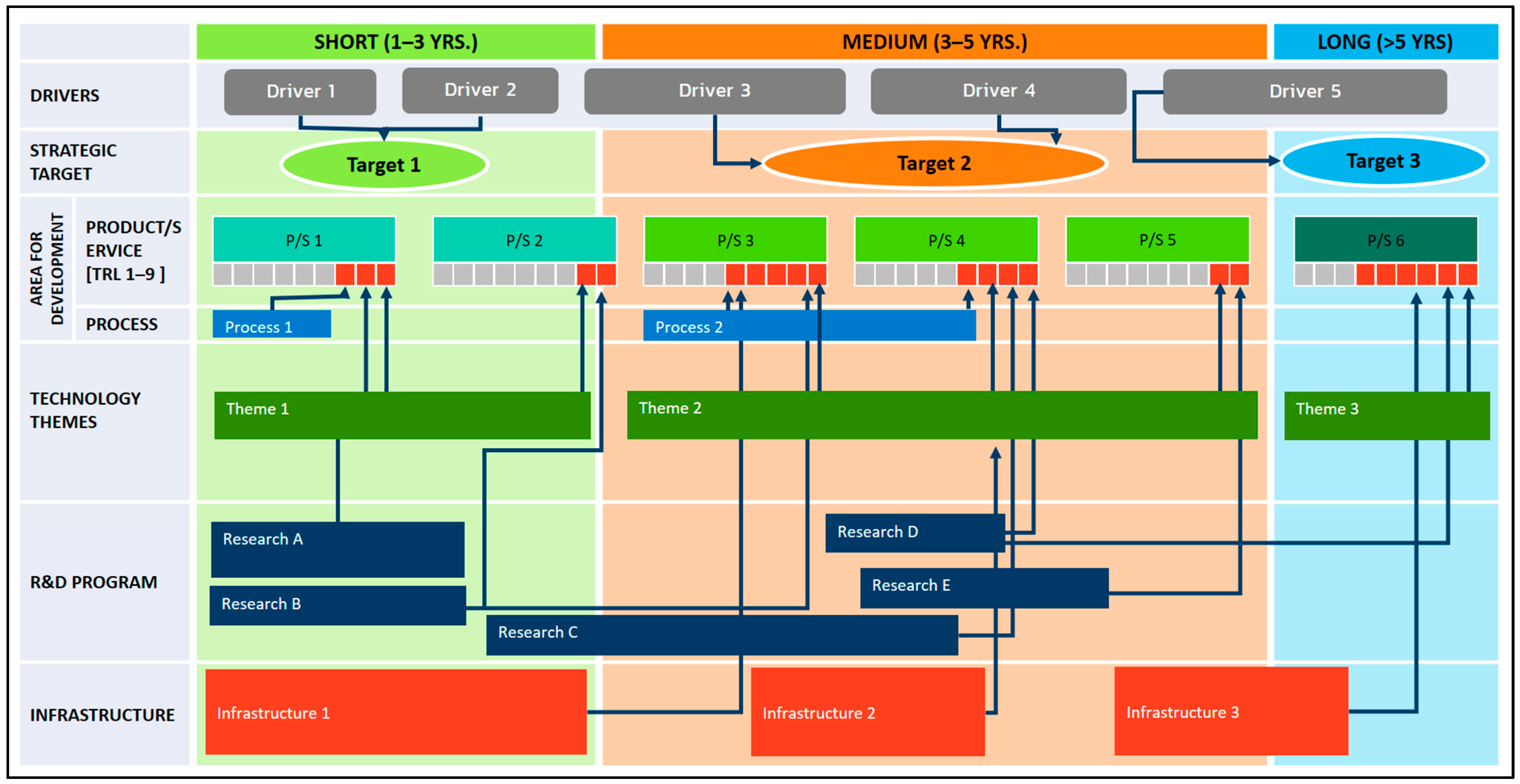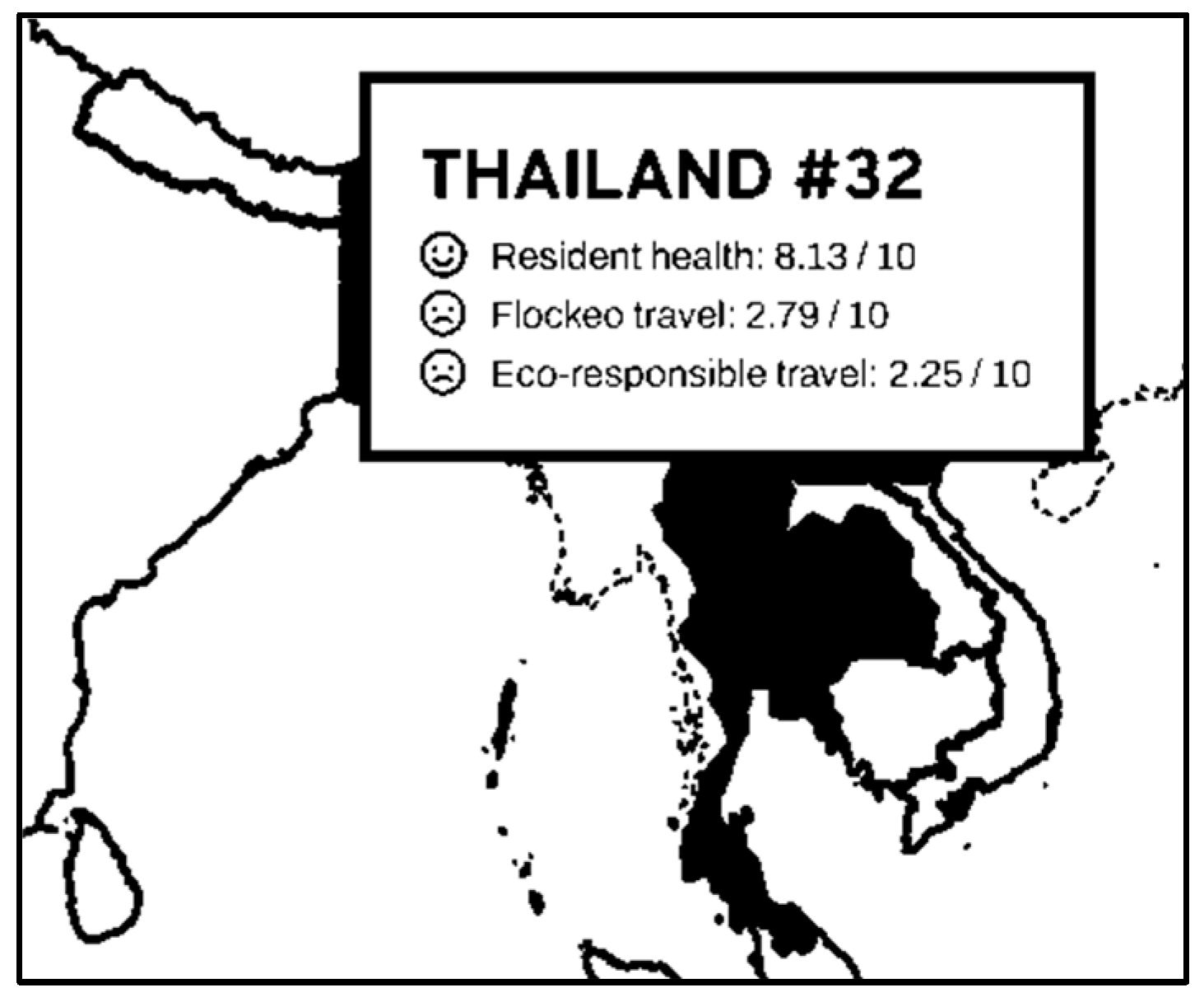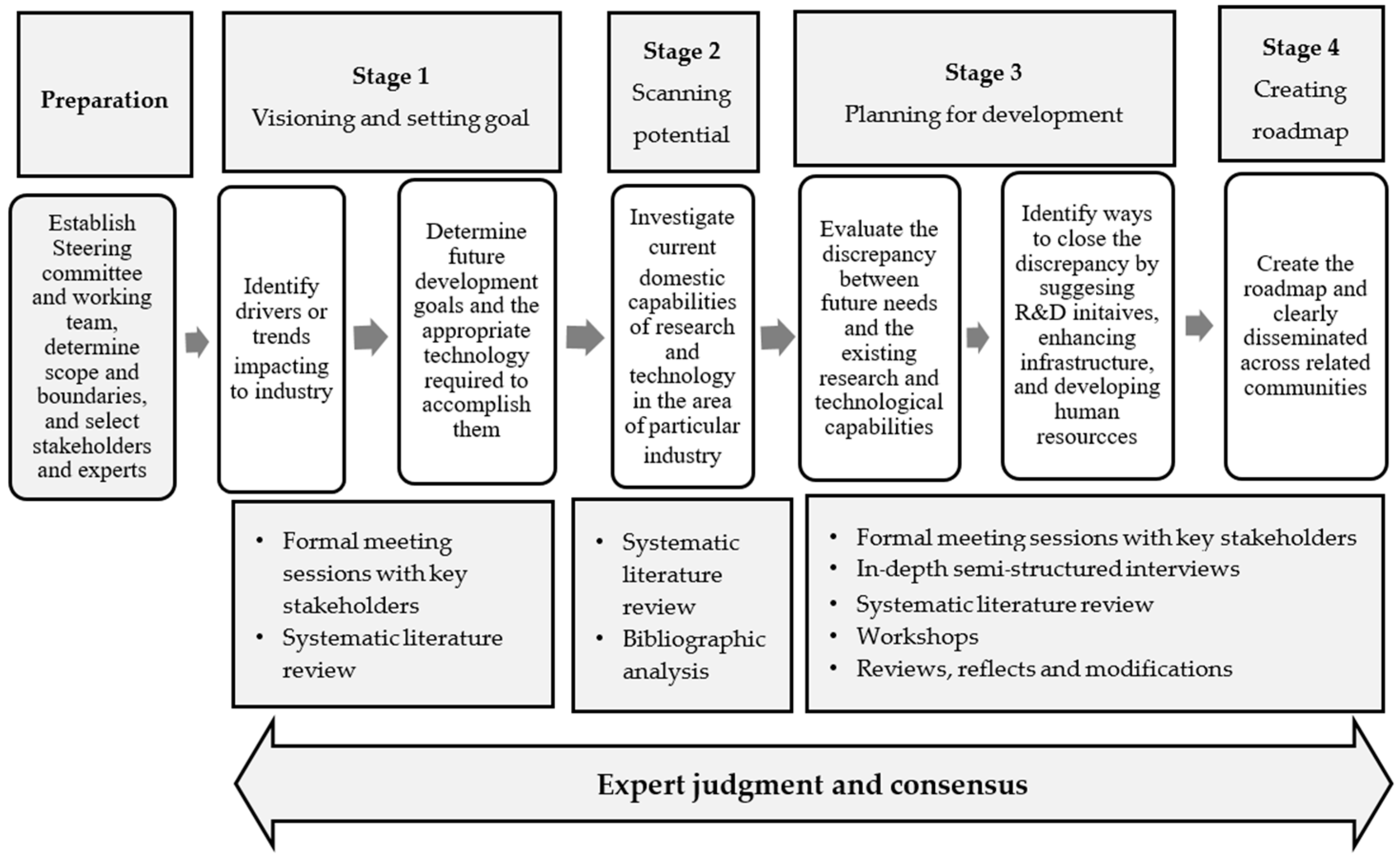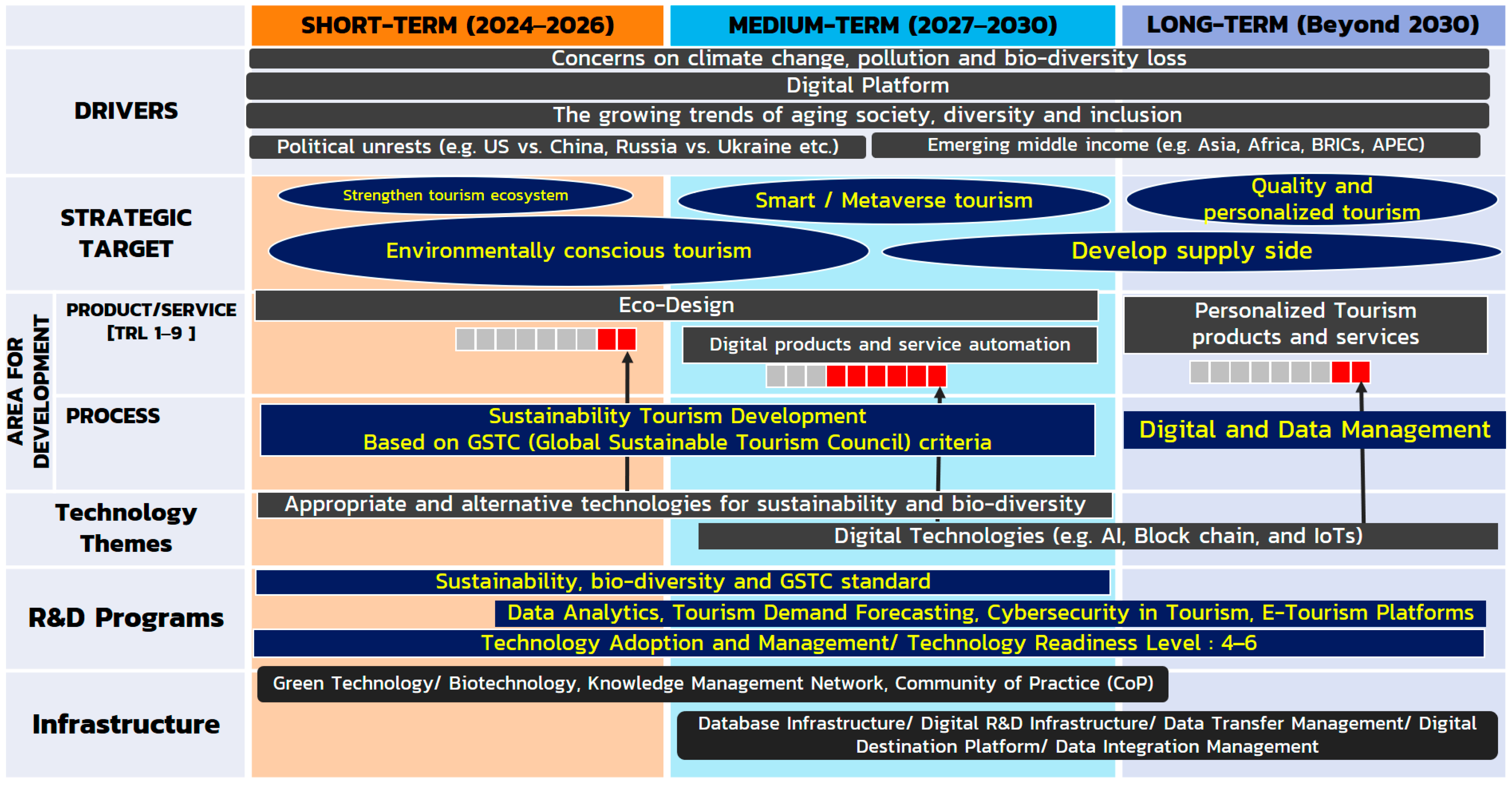Roadmap Toward Sustainable Tourism Development: An Evidence- and Knowledge-Based Approach from Thailand
Abstract
1. Introduction
2. Literature Review
2.1. Sustainable Tourism in Thailand
2.2. Sustainable Tourism: Challenges and Opportunities
3. Methodology
3.1. Roadmapping Approach
3.2. Customized Structure of the National Technology Roadmap
- Drivers—This layer captures the key forces and trends influencing the industry.
- Strategic Targets—Derived from the drivers layer, this tier reflects the government priorities and desired outcomes. It is often referred to as the “Know-Why” layer.
- Areas for Development: Products/Services and Processes with Technology Readiness Levels (TRLs)—Informed by the strategic targets layer, this stage outlines the technological products, services, and processes required to meet these targets. Referred to as the “Know-What” layer, it also incorporates TRLs to indicate the sector’s current state of technological maturity.
- Technology Themes—This layer builds on the areas for development, defining thematic areas or scopes that highlight technological opportunities and capability directions.
- R&D Programs and Infrastructure—These layers are informed by both the technology themes and areas for development and represent the necessary knowledge base, skilled workforce, and physical resources needed to support the roadmap’s goals.

4. Roadmap Development for Sustainable Tourism Industry in Thailand
- Environmental impact of tourism: To investigate how tourism affects ecosystems, wildlife, water and energy consumption, and waste production. This investigation motivates studies on how to minimize tourism’s carbon footprint and promote eco-friendly practices from transportation and energy-efficient accommodations to conservation-based tourism. This area relates to SDG 6: Clean Water and Sanitation, SDG 12: Responsible Consumption and Production, SDG 13: Climate Action, and SDG 15: Life on Land.
- Community-based tourism (CBT): To investigate how tourism can be developed with the participation of local communities, ensuring that they benefit from tourism activities while maintaining control over the cultural and environmental aspects of their areas. This area links to SDG 8: Decent Work and Economic Growth, SDG 10: Reduced Inequalities, and SDG 11: Sustainable Cities and Communities.
- Tourism carrying capacity: To study the limits to the number of visitors a destination can support before environmental or social damage occurs. This area connects to SDG 11: Sustainable Cities and Communities, SDG 12: Responsible Consumption and Production, and SDG 15: Life on Land.
- Sustainable tourism practices for biodiversity conservation: To study the creation and implementation of sustainable tourism models that reduce the environmental footprint. This area addresses SDG 12: Responsible Consumption and Production, SDG 14: Life Below Water, and SDG 15: Life on Land.
- Tourism’s role in supporting indigenous knowledge and biodiversity: To obtain insights on how tourism can support or harm indigenous communities’ traditional knowledge related to biodiversity and conservation and how indigenous practices contribute to sustainable tourism models. This area pertains to SDG 4: Quality Education, SDG 10: Reduced Inequalities, and SDG 15: Life on Land.
- The roles of GSTC standards in tourism management: To investigate how tourism practitioners utilize the GSTC criteria to manage their tourism sustainably, from integrating the standards into destination management plans, marketing sustainable tourism, to monitoring progress toward sustainability goals. This area relates to SDG 8: Decent Work and Economic Growth, SDG 12: Responsible Consumption and Production, and SDG 17: Partnerships for the Goals.
- The adoption and execution of GSTC standards: To shed light on how tourism businesses apply the GSTC criteria. This area also addresses challenges in incorporating GSTC standards into the national roadmap and the industry’s readiness to achieve the sustainability goals. This area links to SDG 9: Industry, Innovation and Infrastructure, SDG 12: Responsible Consumption and Production, and SDG 16: Peace, Justice and Strong Institutions.
- Data analytics in tourism: To study how to use large datasets to understand and predict tourist behaviors, preferences, and trends. This understanding enables businesses and governments to adopt data-driven rationales on decisions, marketing strategies, resource allocation, and service improvements. This area links to SDG 9: Industry, Innovation and Infrastructure, SDG 11: Sustainable Cities and Communities, and SDG 12: Responsible Consumption and Production.
- Tourism Demand Forecasting: To investigate how to use statistics and/or mathematical models to forecast future tourism trends. This forecast enables stakeholders in the tourism sector to strategically manage resources, optimize pricing strategies, and plan for future developments. This area pertains to SDG 8: Decent Work and Economic Growth, SDG 9: Industry, Innovation and Infrastructure, and SDG 12: Responsible Consumption and Production.
- Cybersecurity in Tourism: To examine how to protect customer information, online transactions, and an organization’s computer systems from cyberattacks. This area addresses SDG 9: Industry, Innovation and Infrastructure, SDG 16: Peace, Justice and Strong Institutions, and SDG 17: Partnerships for the Goals.
- E-Tourism Platforms: To understand how these platforms create tourism demand, shape business models, and influence tourist behavior. This area connects to SDG 8: Decent Work and Economic Growth, SDG 9: Industry, Innovation and Infrastructure, and SDG 10: Reduced Inequalities.
5. Discussion and Recommendations
6. Conclusions
Author Contributions
Funding
Institutional Review Board Statement
Informed Consent Statement
Data Availability Statement
Conflicts of Interest
References
- Bank of Thailand. The Transformation of Thailand’s Tourism Industry and the Next Steps After Reopening the Country. 2023. Available online: https://www.bot.or.th/th/research-and-publications/articles-and-publications/bot-magazine/Phrasiam-65-3/the-knowledge-65-3-3.html (accessed on 30 September 2024).
- Leenoi, P. Sustainable Tourism: A New Era of Travel Prioritizing Sustainability. 2024. Available online: https://www.krungsri.com/en/research/research-intelligence/sustainable-tourism-2024 (accessed on 10 January 2025).
- Maziliauske, E. Innovation for sustainability through co-creation by small and medium-sized tourism enterprises (SMEs): Socio-cultural sustainability benefits to rural destinations. Tour. Manag. Perspect. 2024, 50, 101201. [Google Scholar] [CrossRef]
- Sulong, Z.; Chowdhury, M.A.F.; Abdullah, M.; Hall, C. Constructing sustainable halal tourism composite performance index for the global halal tourism industry. Asia Pac. J. Tour. Res. 2024, 29, 852–868. [Google Scholar] [CrossRef]
- United Nations Development Programme (UNDP). What Are the Sustainable Development Goals? Available online: https://www.undp.org/eswatini/sustainable-development-goals (accessed on 30 September 2024).
- Krittayaruangroj, K.; Suriyankietkaew, S.; Hallinger, P. Research on sustainability in community-based tourism: A bibliometric review and future directions. Asia Pac. J. Tour. Res. 2023, 28, 1031–1051. [Google Scholar] [CrossRef]
- Anuroj, B. Thailand 4.0—A new value-based economy. EEC 2017, 4, 5. [Google Scholar]
- Karakas, E.; Atay, L. The impact of smart destination implementations in Malaga. J. Hosp. Tour. Technol. 2023, 14, 815–837. [Google Scholar] [CrossRef]
- Kuščer, K.; Peters, M.; Schönherr, S. Tourism Policymaking in Troubling Times: Sustainability-Driven Challenges, Implemented Policies, and Goals for Sustainable Development. Sustainability 2024, 16, 10599. [Google Scholar] [CrossRef]
- Global Sustainable Tourism Council (GSTC). Tourism Sustainability Development Index. Available online: https://www.tourism-sdi.org/ (accessed on 30 September 2024).
- World Economic Forum. Travel & Tourism Development Index 2024. 2024. Available online: https://www3.weforum.org/docs/WEF_Travel_and_Tourism_Development_Index_2024.pdf (accessed on 15 February 2025).
- Tourism Authority of Thailand. TAT Highlights Meaningful Travel and Sustainable Tourism Direction at ATF 2024. 2024. Available online: https://www.tatnews.org/2024/01/tat-highlights-meaningful-travel-and-sustainable-tourism-direction-at-atf-2024/ (accessed on 30 January 2024).
- Pongsakornrungsilp, P.; Pongsakornrungsilp, S.; Jansom, A.; Chinchanachokchai, S. Rethinking sustainable tourism management: Learning from the COVID-19 pandemic to co-create future of Krabi tourism, Thailand. Sustainability 2022, 14, 11375. [Google Scholar] [CrossRef]
- Sakolnakorn, T.P.N.; Naipinit, A.; Kroeksakul, P. Sustainable tourism development and management in the Phuket province, Thailand. Asian Soc. Sci. 2013, 9, 75. [Google Scholar] [CrossRef]
- Satarat, N. Sustainable Management of Community-Based Tourism in Thailand; National Institute of Development Administration: Bangkok, Thailand, 2010. [Google Scholar]
- Dwyer, L. Sustainable development of tourism: Research and policy challenges. Highl. Sustain. 2023, 2, 83–99. [Google Scholar] [CrossRef]
- Manzoor, F.; Wei, L.; Asif, M.; Haq, M.Z.; Rehman, H. The contribution of sustainable tourism to economic growth and employment in Pakistan. Int. J. Environ. Res. Public Health 2019, 16, 3785. [Google Scholar] [CrossRef]
- Ogato, G.S. Planning for sustainable tourism: Challenges and opportunities for ecotourism development in Addis Ababa, Ethiopia. Am. J. Hum. Ecol. 2014, 3, 20–26. [Google Scholar]
- Makian, S.; Jalalabadi, L.; Qezelbash, A.H. Identifying Sustainable Tourism Indicators of Urban Destinations in Developing Countries Using DEMATEL-ISM. J. Sustain. Res. 2024, 6, 2. [Google Scholar]
- Dias, Á.; Viana, J.; Pereira, L. Barriers and policies affecting the implementation of sustainable tourism: The Portuguese experience. J. Policy Res. Tour. Leis. Events 2024, 1–19, ahead-of-print. [Google Scholar] [CrossRef]
- Tosun, C. Challenges of sustainable tourism development in the developing world: The case of Turkey. Tour. Manag. 2001, 22, 289–303. [Google Scholar] [CrossRef]
- Rasoolimanesh, S.M.; Chee, S.Y.; Salee, A. Scale development for measuring sustainability of urban destinations from the perspectives of residents, tourists, businesses and government. J. Sustain. Tour. 2024, 33, 290–317. [Google Scholar] [CrossRef]
- Fuchs, K. Navigating the Fine Line of Sustainable Tourism: A Critical Analysis with Implications for Tourism Planning. J. Environ. Manag. Tour. 2023, 14, 1908–1914. [Google Scholar] [CrossRef]
- Almughrabi, B. Ecotourism: A Sustainable Approach of Tourism in Jordan. Master’s Thesis, University of Arizona, Tucson, AZ, USA, 2007. [Google Scholar]
- Zhu, L.; Wang, Y. Technological Innovation in Promoting the Sustainable Development of Tourist Factories: Factors Influencing Tourists’ Perceived Value and Loyalty in Immersive VR Experiences. Sustainability 2025, 17, 2871. [Google Scholar] [CrossRef]
- Daim, T.U.; Oliver, T. Implementing technology roadmap process in the energy services sector: A case study of a government agency. Technol. Forecast. Soc. Change 2008, 75, 687–720. [Google Scholar] [CrossRef]
- Gerdsri, N.; Vatananan, R.; Dansamasatid, S. Dealing with the Dynamics of Technology Roadmapping Implementation: A Case Example. Technol. Forecast. Soc. Change 2009, 76, 50–60. [Google Scholar] [CrossRef]
- Gerdsri, N.; Suksiri, P.; Somjaitaweeporn, T.; Sapsaman, T. Robotics and Automation Roadmap: Thailand Perspectives. Int. J. Autom. Technol. 2024, 18, 754–763. [Google Scholar] [CrossRef]
- Kostoff, R.N.; Schaller, R.R. Science and technology roadmaps. IEEE Trans. Eng. Manag. 2001, 48, 132–143. [Google Scholar] [CrossRef]
- Phaal, R.; Muller, G. An architectural framework for roadmapping: Towards visual strategy. Technol. Forecast. Soc. Change 2009, 76, 39–49. [Google Scholar] [CrossRef]
- Gerdsri, N.; Puengrusme, S.; Vatananan, R.; Tansurat, P. Conceptual framework to assess the impacts of changes on the status of a roadmap. J. Eng. Technol. Manag. 2019, 52, 16–31. [Google Scholar] [CrossRef]
- Phaal, R.; Farrukh, C.J.P.; Probert, D.R. Developing a technology roadmapping system. In Proceedings of the Portland International Conference on Management of Engineering and Technology (PICMET 2004), Portland, OR, USA, 1–5 August 2004. [Google Scholar]
- Vatananan, R.S.; Gerdsri, N. The current state of technology roadmapping (TRM) research and practice. In Proceedings of the PICMET 2010 Technology Management for Global Economic Growth, Phuket, Thailand, 18–22 July 2010; pp. 1–10. [Google Scholar]
- Liang, A.R.-D.; Kuo, Y.-C.; Liu, Y.-H.; Chang, T.-W. The use of co-creation within the community-based tourism experiences. Tour. Manag. Perspect. 2023, 48, 101157. [Google Scholar] [CrossRef]
- Intarakumnerd, P.; Gerdsri, N. Implications of Technology Management and Policy on the Development of a Sectoral Innovation System: Lessons Learned Through the Evolution of Thai Automotive Sector. Int. J. Innov. Technol. Manag. 2014, 11, 1440009. [Google Scholar] [CrossRef]
- Yasunaga, Y.; Watanabe, M.; Korenaga, M. Application of technology roadmaps to governmental innovation policy for promoting technology convergence. Technol. Forecast. Soc. Change 2009, 76, 61–79. [Google Scholar] [CrossRef]
- Kim, S.; Choi, C. Strategic technology roadmapping for inter-ministry R&D cooperation. Int. J. Technol. Manag. 2018, 76, 236–257. [Google Scholar]
- Guerra, R.J.D.C.; Gonçalves, E.C.C. Co-Creation of Sustainable Tourism and Hospitality Experiences: Education and Organizations in Search of New Business Models. Sustainability 2024, 16, 321. [Google Scholar] [CrossRef]
- Rinaldi, C.; Cavicchi, A.; Robinson, R.N. University contributions to co-creating sustainable tourism destinations. J. Sustain. Tour. 2022, 30, 2144–2166. [Google Scholar] [CrossRef]
- Manotungvorapun, N.; Gerdsri, N. University–industry collaboration: Assessing the matching quality between companies and academic partners. IEEE Trans. Eng. Manag. 2019, 68, 1418–1435. [Google Scholar] [CrossRef]
- Banal-Estañol, A.; Macho-Stadler, I.; Pérez-Castrillo, D. Endogenous Matching in University-Industry Collaboration: Theory and Empirical Evidence from the UK. CESifo Work. Pap. 2013, 4340. [Google Scholar]
- Gerdsri, N.; Kongthon, A.; Puengrusme, S. Profiling the Research Landscape in Emerging Areas Using Bibliometrics and Text Mining: A Case Study of Biomedical Engineering (BME) in Thailand. Int. J. Innov. Technol. Manag. 2017, 14, 1740011. [Google Scholar] [CrossRef]
- Office of the National Higher Education, Science, Research and Innovation Policy Council (NXPO). Thailand Quantum Technology Roadmap 2020–2030; NXPO: Bangkok, Thailand, 2020.
- Manotungvorapun, N.; Gerdsri, N. Positioning academic partners to align with proper modes of university-industry collaboration. Int. J. Bus. Innov. Res. 2021, 24, 261–296. [Google Scholar] [CrossRef]
- Hoffmann, W.H. How to Manage a Portfolio of Alliances. Long Range Plan. 2005, 38, 121–143. [Google Scholar] [CrossRef]
- Lin, W.-R.; Lee, S.-S.; Huang, W.-S. A scale for measuring tourists’ technological competence. J. Hosp. Tour. Technol. 2023, 14, 802–814. [Google Scholar] [CrossRef]
- Ministry of Industry, Science, Technology & Innovation. TourismTech Roadmap: Accelerating Cambodia’s Tourism Sector Through Innovative and Sustainable Technologies; Ministry of Industry, Science, Technology & Innovation: Phnom Penh, Cambodia, 2022.



| Economy | Japan | Australia | China | Korea, Rep. | Singapore | Indonesia | Malaysia | Thailand | Vietnam | |
|---|---|---|---|---|---|---|---|---|---|---|
| TTDI Rank | 3 | 5 | 8 | 14 | 13 | 22 | 26 | 47 | 59 | |
| Enabling Environment | Business Environment | 5.38 | 5.62 | 4.73 | 4.84 | 6.15 | 4.67 | 4.91 | 4.15 | 4.06 |
| Safety and Security | 5.98 | 5.97 | 6.52 | 6.29 | 6.82 | 5.77 | 5.88 | 4.87 | 6.19 | |
| Health and Hygiene | 6.23 | 5.98 | 5.27 | 6.21 | 5.14 | 3.78 | 4.81 | 4.31 | 4.3 | |
| Human Resources and Labor Market | 4.9 | 5.23 | 4.51 | 4.58 | 5.14 | 4.13 | 4.35 | 4.5 | 4.53 | |
| ICT Readiness | 6.03 | 6.19 | 6.17 | 6.56 | 5.36 | 5.83 | 5.89 | 5.16 | 5.18 | |
| Travel and Tourism Policy and Enabling Conditions | Prioritization of Travel and Tourism | 4.78 | 4.9 | 3.84 | 4.56 | 5.71 | 6.03 | 4.25 | 3.96 | 5.63 |
| Openness to Travel and Tourism | 4.06 | 4.85 | 3.89 | 3.87 | 5.7 | 3.83 | 4.16 | 4.13 | 3.61 | |
| Price Competitiveness | 4.34 | 2.75 | 5.17 | 4.55 | 2.67 | 4.44 | 4.06 | 3.89 | 3.68 | |
| Infrastructure and Services | Air Transport Infrastructure | 5.34 | 5.23 | 5.26 | 4.69 | 5.94 | 3.44 | 4.18 | 4.41 | 3.61 |
| Ground and Port Infrastructure | 6.08 | 3.68 | 4.57 | 5.4 | 6.54 | 3.97 | 4.05 | 4.2 | 4.14 | |
| Tourist Services and Infrastructure | 2.93 | 4.62 | 1.95 | 2.82 | 4.11 | 1.79 | 2.96 | 3.21 | 2.2 | |
| Travel and Tourism Resources | Natural Resources | 5.11 | 6.42 | 6.2 | 2.36 | 1.57 | 5.46 | 4.18 | 4.13 | 3.92 |
| Cultural Resources | 6.71 | 3.78 | 6.59 | 5.59 | 1.75 | 5.17 | 4.75 | 3.07 | 2.85 | |
| Non-Leisure Resources | 5.93 | 5.09 | 5.79 | 4.72 | 3.8 | 4.36 | 4.4 | 4.33 | 3.66 | |
| Travel and Tourism Sustainability | Environmental Sustainability | 5.2 | 5.18 | 4.46 | 4.7 | 4.37 | 4.34 | 4.31 | 4.24 | 4.13 |
| Travel and Tourism Socioeconomic Impact | 4.57 | 5 | 5.36 | 5.25 | 4.38 | 5.41 | 5.04 | 4.13 | 3.8 | |
| Travel and Tourism Demand Sustainability | 3.02 | 4.46 | 3.79 | 3.67 | 4.14 | 4.84 | 3.84 | 3.47 | 3.96 | |
| Category | Title/Role | Count | Expertise/Experience |
|---|---|---|---|
| Government officials | Policymakers/policy developers | 20 |
|
| Tourism authorities | 20 | ||
| Academia | Tourism professors | 10 |
|
| Technology and innovation researchers | 10 |
| |
| Business management professors (with a focus on tourism) | 5 |
| |
| Industry practitioners | Hotel and accommodation sector | 5 |
|
| Tour operators and travel agencies | 5 | ||
| Technology solution providers | 3 |
| |
| Tourism tech start-up founders | 7 |
| |
| Tourism experts | Cultural heritage and ecotourism specialists | 8 |
|
| Travel journalists and influencers | 12 |
|
Disclaimer/Publisher’s Note: The statements, opinions and data contained in all publications are solely those of the individual author(s) and contributor(s) and not of MDPI and/or the editor(s). MDPI and/or the editor(s) disclaim responsibility for any injury to people or property resulting from any ideas, methods, instructions or products referred to in the content. |
© 2025 by the authors. Licensee MDPI, Basel, Switzerland. This article is an open access article distributed under the terms and conditions of the Creative Commons Attribution (CC BY) license (https://creativecommons.org/licenses/by/4.0/).
Share and Cite
Manotungvorapun, N.; Gerdsri, N. Roadmap Toward Sustainable Tourism Development: An Evidence- and Knowledge-Based Approach from Thailand. Sustainability 2025, 17, 6028. https://doi.org/10.3390/su17136028
Manotungvorapun N, Gerdsri N. Roadmap Toward Sustainable Tourism Development: An Evidence- and Knowledge-Based Approach from Thailand. Sustainability. 2025; 17(13):6028. https://doi.org/10.3390/su17136028
Chicago/Turabian StyleManotungvorapun, Nisit, and Nathasit Gerdsri. 2025. "Roadmap Toward Sustainable Tourism Development: An Evidence- and Knowledge-Based Approach from Thailand" Sustainability 17, no. 13: 6028. https://doi.org/10.3390/su17136028
APA StyleManotungvorapun, N., & Gerdsri, N. (2025). Roadmap Toward Sustainable Tourism Development: An Evidence- and Knowledge-Based Approach from Thailand. Sustainability, 17(13), 6028. https://doi.org/10.3390/su17136028






